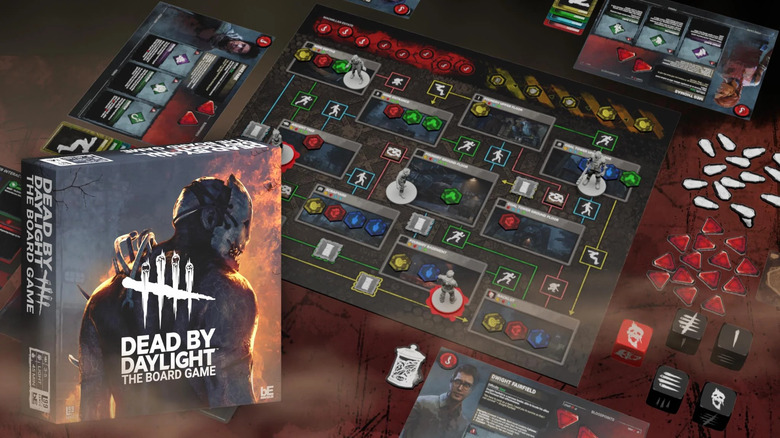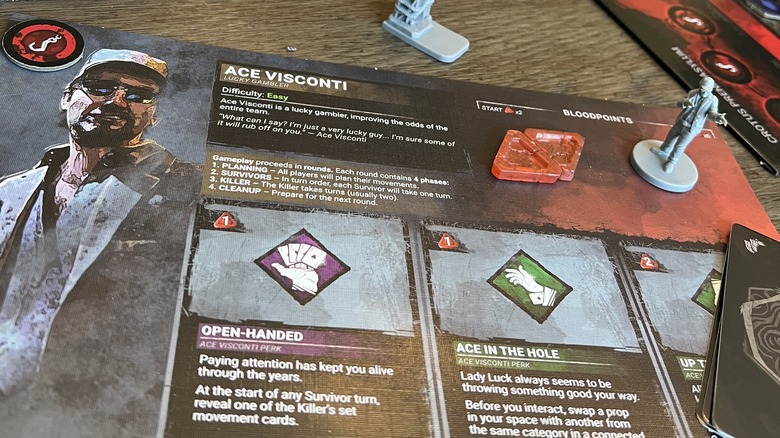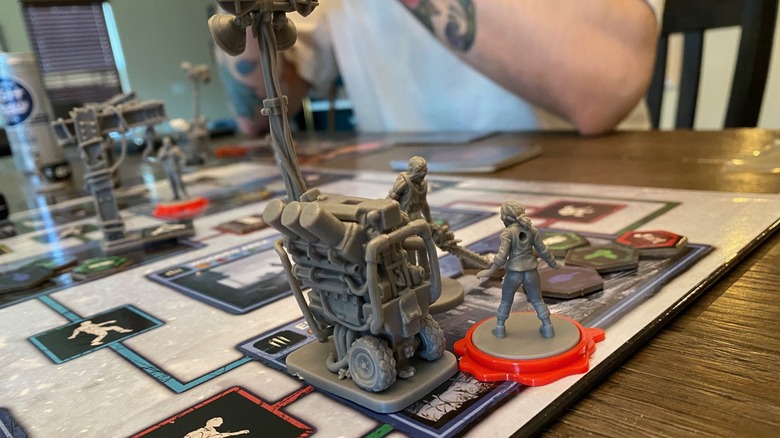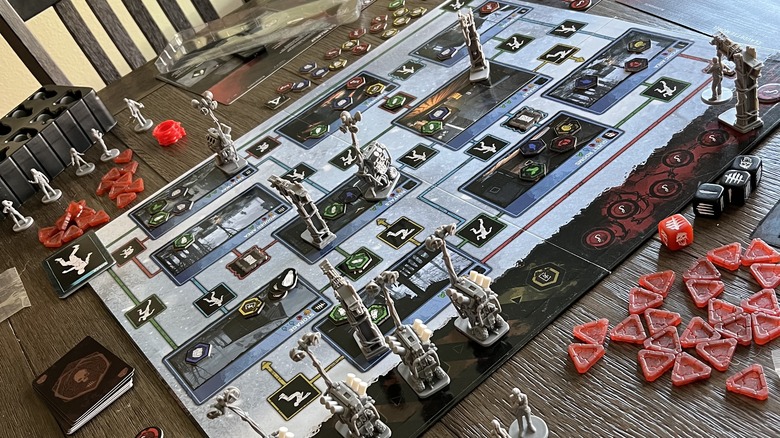Dead By Daylight: The Board Game Lets You Kill Your Friends
It's been a big year for the "Dead By Daylight" franchise. Not only did they add Nicolas Cage to their ever-expanding Rolodex of in-game survivors, but they also managed to make the jump from pixels to cardboard, completing the Kickstarter for the much-anticipated release of "Dead By Daylight: The Board Game." And with all due respect to "Five Nights at Freddy's," that makes this one of the biggest cross-media titles in horror history.
But while Level 99 Games may have struck gold in the past with "Bullet," the company's previous puzzle-battling game, "Dead By Daylight: The Board Game" offers a more high-stakes excursion into the world of classic (and modern) movie monsters. In this review, we'll discuss why my regular board game group did not like the game — and why that approach only confirmed my desire to keep this one in my collection indefinitely.
Gameplay mechanics
For those who haven't played the video game, "Dead By Daylight" is an asymmetrical horror game where four survivors try to escape the clutches of a terrible killer. Survivors work together to locate and repair generators scattered across a large map. Meanwhile, the killer — often a licensed horror icon like Ghostface from "Scream" or Pyramid Head from the "Silent Hill" franchise — stalks their victims, knocking them to the ground and sacrificing them to a mysterious entity that serves as their patron.
Theoretically, this should make "Dead By Daylight" a game of subtle movements. In practice, it is much more a game of chicken. Players run interference, force distractions, and do their best to juke killers as both parties run around the map. And if that sounds like fun, you will probably find a kindred spirit in developer Level 99 Games, who have faithfully recreated the gameplay experience for "Dead By Daylight: The Board Game."
The killer and the survivors start on a board with multiple rooms mirroring the locations found in-game. Each room is linked to neighboring locations through a type of movement arrow — such as sneak, crouch, or vault — that matches the symbols on both groups' player cards. At the start of each turn, everyone will select a card from their movement deck that determines how they will move around the board. The object is to anticipate your opponent's moves, choosing the space they think you are going to avoid (or the space they know you're going to move to, thereby suggesting that you won't, so of course you do).
Each round can be broken down into four phases. In the first phase, players choose their movement cards based on their goals, including fleeing the killer or hunting for one of the facedown generator tokens on the board. In the second phase, survivors reveal their movement and interact with one of the prop tokens in their target room. Next, the killer goes, taking two turns back-to-back before the first-player token rotates and the series begins anew.
Fight or flight
Like the video game, the survivors aim to find and repair generator tokens to power up the exit gates. Meanwhile, the killer seeks to sacrifice the survivors — if even one escapes, you lose. Like most hidden movement games — such as "Fury of Dracula" or "Letter From Whitechapel" — bridging the gap between what might happen and what you do is the most challenging part of the game. Nothing is more frustrating as a killer than having players anticipate your move and slip into spaces you never planned to move to.
But player movement is not the only mechanic in "Dead By Daylight: The Board Game." Survivors and killers have a handful of custom powers that can be activated using a pool of resources called Bloodpoints. You unlock significant buffs for your turns as you collect Bloodpoints — typically tied to the outcome of six-sided dice used for skill checks. These abilities may let you move farther, avoid obstacles, or even elect to take a third turn altogether in the case of the killer.
How you string these options together will determine how successful you are at the game. Do you spend your time damaging generators as the killer, or instead try controlling the movement flow on the map to limit your opponents' options as the game unfolds? As survivors, do you focus on repairing a revealed generator or take a chance on a facedown token on the other side of the map? "Dead By Daylight: The Board Game" is a constant balance of risks and rewards, with gameplay that only benefits from an increased understanding of your opponents' abilities and tendencies as a player.
And admittedly, it was a balancing act my group never got quite right. Despite being down a person at the table, our four-player group selected two people to trade off the role of the killer. To our surprise, this was the most frustrating role at the table. Both killers were treated to a full-court survivor blitz; our opponents flew around the board, vacating the spaces we thought they would occupy and ruining entire turns for the killer before we'd even had our chance to reveal our movement cards. What should have felt like a position of great power instead felt like a stressful night at the Whack-A-Mole machine.
Those two sessions sparked an existential crisis for my semi-regular board game group. We agreed that there were a lot of great mechanics here, but no "Dead By Daylight: The Board Game" session had felt remarkably balanced for our players. Was this an unbalanced board game with many fancy Kickstarter bells and whistles — not uncommon in the tabletop industry? Or would the core mechanics become more manageable after repeated playthroughs with a group?
A faithful adaptation
Even as the rest of the group soured on the experience, I found there was something about "Dead By Daylight: The Board Game" that resonated with me. The sheer wealth of options and character customization available to players — not to mention the speed at which the game plays — spoke to me in a way that even more highly-regarded and asynchronous board games would not. And while my table agreed that neither individual playthrough felt balanced, I couldn't shake the notion that this was the kind of game that was best evaluated at scale.
So I did something I hadn't done in years: I sat down and played the "Dead By Daylight" video game every night for a week straight.
As I switched between a killer and a survivor, I quickly refamiliarized myself with the game and the frustrating tendencies of other players. The more games I finished, the more I realized that "Dead By Daylight: The Board Game" captures the video game experience with uncanny precision. In the video game, sessions are short-lived, and it is not uncommon for the group to escape while losing one or even zero survivors. These are elements that Level 99 Games has recreated perfectly in the board game; even if you master the meta-game, there will still be times when one group or the other just fully runs the table.
It can be frustrating to watch a game slip through your fingertips as a board game player, but that wasn't exactly an uncommon experience for me with the video game version of "Dead By Daylight." And I would argue that the frustration of playing out the string in a losing scenario is directly proportionate to how much time you invest in the game. If "Dead By Daylight" had a two-hour playtime, these imbalances might be enough to sink it. But much like the video game, after both sessions, I wanted to jump back in and try to apply what I had learned immediately. "Dead By Daylight: The Board Game" feels like a title that knowingly accepts not every session is going to be great, and that's a very video game mindset for a tabletop title.
So is it worth it? Therein lays the million dollar — or, according to most retailers, the $39.99 — question. Several members of our group made it clear that they would never try "Dead By Daylight" again, an opinion I can completely understand. But as the rare board game that can be genuinely completed in well under an hour, I found myself evaluating "Dead By Daylight" as a fascinating volume play. This game is simple but varied enough to support multiple playthroughs. There may be more balanced games on the market for one-off game nights, but I can honestly say I would rather play three sessions of this than most three-hour games I can think of. And that means it'll stick in my collection long after so-called "better" games have come and gone.



